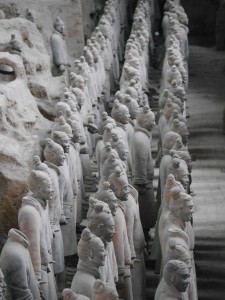西安
虽然我已经在中国居住了10个月,但一直没找到合适的机会去参观一个重要景点——兵马俑。我的朋友来中国旅行,要我跟他一起去西安游览名胜古迹,这个愿望终于得以实现。
我们决定坐便宜的慢速火车去西安。坐这种火车的体验很特别,可以让我朋友很快地适应中英文化差别。火车站挤满了背着大包小裹的游客及民工。辛亏我们是上铺 ,可以逃避人们好奇的眼光。
我们刚抵达西安就坐车来到兵马俑。我之前听说兵马俑景点常常人满为患,有可能一个展品也看不见,可事实上并不是这样:有些兵马俑遗址让我感到非常震惊——大概跟足球场差不多大。最可观的是细微之处——每个勇士脸上都有着独特的表情。
除了兵马俑外,西安值得游览的名胜古迹已经为数不多。虽然西安是一座知名的文化古都,但许多古代文物、古代文化遗产均已失传。现在,大型工厂代替了古代建筑, 浓重污染代替了古代文化。
虽然传统中国文化不太丰富,西安却也是中国穆斯林文化的主要聚集地。回民街上充满五彩霓红灯和售卖阿拉伯美味的小摊子。我们还品尝了夹着牛肉的中式煎饼。绝无仅有特色菜肴表现了中国文化与阿拉伯文化的完美融合。
西安唯一保存完好的古代建筑就是古城墙了。为了领略这里的美景,我们租用了一台双人自行车,可是那天雾霾严重,看不清城墙外边。我看着美丽的古城墙与这座饱受工业污染的城市,体会到新旧文化的碰撞依然是现代中国的一个本质方面。
ENGLISH TRANSLATION:
Despite living in China for the last 10 months, there was one key sight I had yet to see: perhaps the most famous of them all – the Terracotta Warriors. A friend from home’s visit gave me the perfect excuse to escape to Xi’an for a few days to show him the sights and tick off the final item on my China bucket list.
We decided to take the cheaper overnight train on the way there. This was quite a different experience to a trip on the bullet train, and gave my visiting friend a baptism of fire in adjusting to cultural differences. We were quite the spectacle in the station full of migrant workers and tradesmen carting huge sacks of produce to and fro. Fortunately on the train itself we were at the top of the triple bunk beds so avoided the plethora of curious stares.
We arrived in Xi’an and went straight to the Terracotta Warriors. Having heard tales of the exhibits being so crowded that it was impossible to even get a glimpse, I had prepared to be disappointed. However, the reality couldn’t have been more different. The first thing I noticed was the sheer size of the main pit – it must be around the size of a football pitch, if not larger. However, it is the detail that is most impressive – each warrior has a unique face and expression.
Xi’an is known almost exclusively for the Terracotta warriors for a good reason – despite once being the capital of China, there is sadly little left from its former glory days as the capital of an ancient civilisation. Instead industrialisation has become the main priority and engulfed the city in smog and factory infrastructure.
While Chinese history and culture may be in short supply, Xi’an has become a hub for Chinese Muslims. The main street in the Muslim quarter is a bustling avenue of neon lights and fragrant Chinese-Arab delicacies. The interesting blend of cultures is personified by the cuisine – we were treated to tagine style beef served in a Chinese pancake.
The only remaining relic of Xi’an’s rich past is the majestic city wall. We hired tandems to cycle along it, but unfortunately Xi’an showed its roots as a centre of industry and the pollution was so bad we could barely see past the edge of the wall. This did however make for an interesting contrast of old and new China, a juxtaposition I have grown to realise in an intrinsic part of China today.

